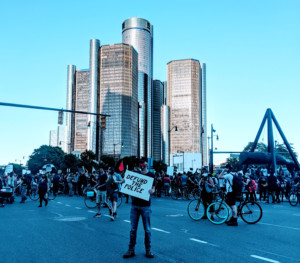SITU Research, one of three distinct divisions of Brooklyn-based architecture practice SITU along with SITU Studio and SITU Fabrication, has released Choking Dissent: How Tear Gas is Used to Crush Protests, an illuminating—and sobering—video analysis exploring how exactly this “less lethal” chemical weapon works and, perhaps more critically considering current events, how it is grossly abused in the public space.
The nearly 5-and-a-half-minute primer video was produced as part of a larger global exploration into tear gas headed by Amnesty International, which documents the improper use of tear gas at 80 events in 22 different countries and territories. A year in the making, Amnesty International has made its findings available through a recently launched interactive multi-media website that, per the human rights organization, “looks into what tear gas is, how it is used and documents scores of cases of its misuse by security forces worldwide, often resulting in severe injuries or death.”
Formally known as a lachrymator agent, tear gas, which causes severe temporary eye and lung irritation but can also lead to harmful long-term health effects, is by no means a new type of munition despite its recent resurgence in the United States. It was deployed heavily in World War I and during subsequent global conflicts. Contained in aerosol cans, mace is a commercially available, pepper spray-based form of tear gas that’s been widely used in non-combat scenarios since the 1960s as a form of self-defense. Awareness of tear gas and its use has grown significantly both abroad—particularly in Hong Kong—and at home in the wake of its use by local police departments and other law enforcement apparati across the United States against those protesting racial injustice in public places following the killing of George Floyd in Minneapolis.
“Security forces often lead us to believe tear gas is a ‘safe’ way to disperse violent crowds, avoiding having to resort to more harmful weaponry. But our analysis proves that police forces are misusing it on a massive scale,” said Sam Dubberley, head of the Evidence Lab on Amnesty International’s Crisis Response Program, in a statement. “We documented police forces using tear gas in ways that it was never intended to be used, often in large quantities against largely peaceful protesters or by firing projectiles directly at people, causing injuries and deaths.”
SITU Research specifically mentions the recent use of pepper balls and tear gas in Washington, D.C., and Seattle against largely peaceful protestors as examples of pepper spray being egregiously misemployed. “At a time when the right to assemble has never been more important, it is critical that the abuse of this weapon and the extent of the damage it causes are clearly understood,” explained SITU Research, noting that “until it can be effectively regulated, its use in American cities should be banned.” (It’s worth noting that SITU Research has delved into this particular topic before but with a focus outside of the U.S.)
In addition to laying out the basic mechanics of tear gas, SITU Research delves into the environment in which it is currently so widely abused. “By examining both weapon and environment, we begin to complete our understanding of the dangers and the inherent risk of abuse,” explains the firm. “We learn that because tear gas is often used in urban contexts, architecture and infrastructure can become weaponized. The city itself becomes complicit in strategies to trap, overwhelm or target civilians.”
You can watch Chocking Dissent in full below.
Other recent projects from SITU Research include the development of prototype “walk-through” COVID-19 testing booths geared for urban areas where the popular drive-through testing model found in rural and suburban areas is infeasible.











